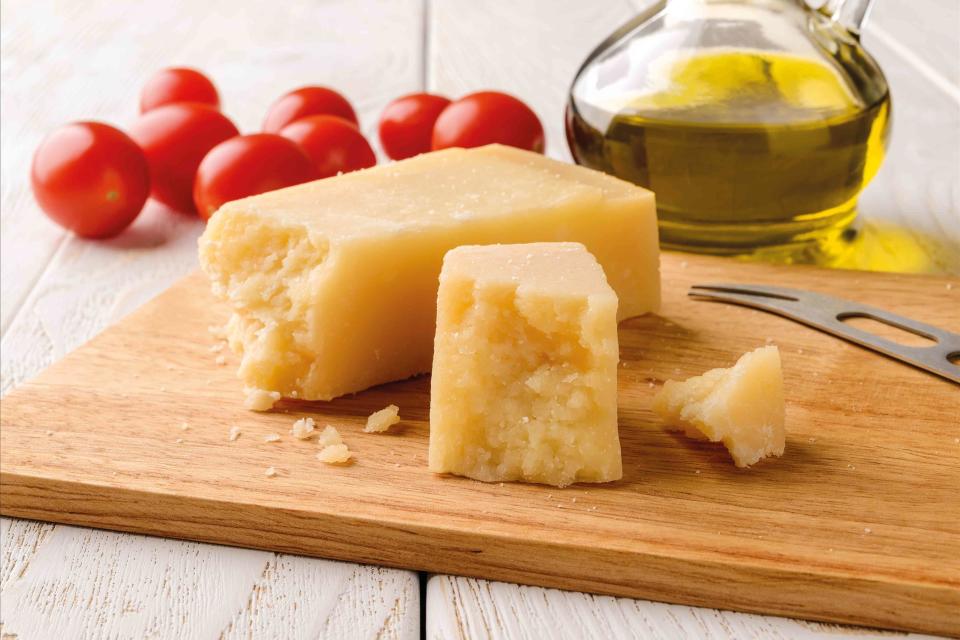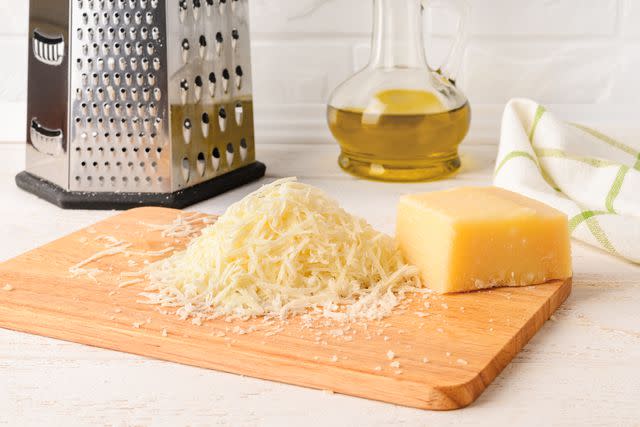How To Store Real Parmesan, According to a Cheese Expert
Keep your cheese fresh, flavorful, and ready for pasta night.

Simply Recipes / Getty Images
As the granddaughter of Italian immigrants, the importance of good parm was drilled into me from a young age. My grandparents were so dedicated to the real thing that they would overnight blocks of Parmigiano Reggiano to us from Brooklyn. The cheese usually arrived intact, but it would occasionally mold if not overnighted.
Recently, I picked up a tub of grated parmesan and wondered why that stuff stays so fresh when the blocks of cheese from my childhood were much more perishable. So I consulted Chef Michele Casadei Massari, U.S. Brand Ambassador for Parmigiano Reggiano, to ask some storage questions.
The Best Way To Store Parmigiano Reggiano
Massari always recommends "buying Parmigiano in a wedge or whole piece as opposed to buying it pre-grated,” as the cheese's flavor and texture diminish in pre-grated options.
Store the cheese in a glass or plastic container or in cling wrap. “Always store your Parmigiano in the refrigerator, far from other food, as the cheese tends to absorb other smells in your fridge,” he advises.
While Massari is referring to Parmigiano Reggiano, parmesan and other similar hard cheeses can be stored the same way and should always be refrigerated.
How Long Will Parmigiano Reggiano Last?
When vacuum-packed, the cheese can last in the fridge for several months. Like all food items, check the best by date on your package for guidance.
Aside from that, “when buying a freshly-cut piece of Parmigiano, how long it will keep will vary depending on its maturation—a maturation of 12 to 18 months (so a higher moisture content) can be kept for about 15 days. Parmigiano Reggiano with a maturation of 24 months can be kept for about one month.”
In other words, the more mature or "aged" the Parmigiano, the longer it will keep.

Simply Recipes / Getty Images
What Are Telltale Signs That Parmigiano Reggiano Has Gone Bad?
If your cheese has an acrid scent, toss it. Otherwise, “a little mold developing on the cheese isn’t necessarily a sign that it has gone bad or deteriorated in quality but rather a side effect of a little humidity.” As long as you cut away any mold, you can continue enjoying the cheese.
With pre-grated cheese, the presence of mold means you should discard the whole container.
If your cheese is hard or dried out, you can’t “rescue” it, but there are many ways to use the rinds. You can add them to soups and risotto to infuse them with flavor, discarding the rind before serving.
Ultimately, “if you take good care of your Parmigiano,” says Massari, “it should last according to the ‘best before date’.”
What's the Difference Between Parmigiano Reggiano and Parmesan?
Massari reminded me there is a difference between parmesan and Parmigiano Reggiano (just like Nonna said!) even if the terms are sometimes used interchangeably.
“Parmigiano Reggiano bears the EU designation of Protected Designation of Origin (PDO),” he says, “which indicates that it has distinctive characteristics tied to its area of origin. It must be produced in the provinces of Parma, Reggio Emilia, Modena, Mantua, or Bologna.”
This protected cheese is also distinguished by unique aging processes. Made with only three ingredients (rennet, salt, and unpasteurized milk), Parmigiano's production adheres to strict “established artisanal and natural methods.”
This explains why that store-bought grated parmesan tends not to mold as readily as hunks of Parmigiano Reggiano: anti-molding agents are often added to extend its shelf life (you'll never find those in real Parmigiano Reggiano).
Furthermore, says Massari, “every single wheel of Parmigiano Reggiano is inspected by a master from the Consorzio del Parmigiano Reggiano, the product’s official governing body.”
Similar cheeses made in the United States, like parmesan, “are not subject to the strict aging requirements, regulations, and quality standards of Parmigiano Reggiano,” explains Massari. “The flavor of the two products vastly varies.”
Read the original article on Simply Recipes.

